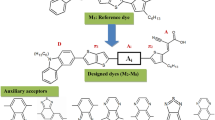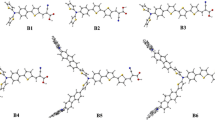Abstract
A benzothiadiazole based solution-processable organic dye D1 (N 4-Phenyl-N 4,N 7,N 7-tri{4-[(2-ethoxycarbonyl)-2-cyanovinyl]phenyl}benzo[c][1,2,5]thiadiazole-4,7-diamine) was synthesized. Dye-sensitized solar cells (DSSCs) were fabricated based on D1 and a commercially available benzothiadiazole based RK1 dye. The photovoltaic parameters of these cells were studied under simulated AM 1.5 illumination (100 mW cm−2). The DSSC sensitized by RK1 dye provided a power conversion efficiency of 5.7 % with high values of short-circuit photocurrent density, open-circuit photovoltage, and fill factor. Under the same conditions, the cell sensitized with D1 dye showed a very poor performance due to the lower values of short-circuit photocurrent density and open-circuit photovoltage. In order to provide insight into poor performance of the DSSC sensitized by D1, molecular structure of D1 was analyzed by density functional theory. Its frontier orbitals were calculated to investigate effectiveness of charge transport and reasons of the poor performance. This computational study revealed that the photovoltaic performance of the benzothiadiazole based DSSCs can be enhanced significantly by inserting a phenyl ring between the benzothiadiazole unit and the anchoring group.







Similar content being viewed by others
References
B. O’Regan, M. Grätzel, A low-cost, high-efficiency solar cell based on dye-sensitized colloidal TiO2 films. Nature 353, 737–740 (1991)
S. Ardo, G.J. Meyer, Photodriven heterogeneous charge transfer with transition-metal compounds anchored to TiO2 semiconductor surfaces. Chem. Soc. Rev. 38, 115–164 (2009)
S. Sigdel, H. Elbohy, J. Gong, N. Adhikari, K. Sumathy, H. Qiao et al., Dye-sensitized solar cells based on porous hollow tin oxide nanofibers. IEEE Trans. Electron Devices 62, 2027–2032 (2015)
H. Elbohy, A. Aboagye, S. Sigdel, Q. Wang, M.H. Sayyad, L. Zhang et al., Graphene-embedded carbon nanofibers decorated with Pt nanoneedles for high efficiency dye-sensitized solar cells. J. Mater. Chem. A 3, 17721–17727 (2015)
M.K. Nazeeruddin, E. Baranoff, M. Grätzel, Dye-sensitized solar cells: a brief overview. Sol. Energy 85, 1172–1178 (2011)
X. Yu, J. Zhu, Y. Zhang, J. Weng, L. Hu, S. Dai, SnSe2 quantum dot sensitized solar cells prepared employing molecular metal chalcogenide as precursors. Chem. Commun. 48, 3324–3326 (2012)
J. Nissfolk, K. Fredin, A. Hagfeldt, G. Boschloo, Recombination and transport processes in dye-sensitized solar cells investigated under working conditions. J. Phys. Chem. B 110, 17715–17718 (2006)
M. Grätzel, Conversion of sunlight to electric power by nanocrystalline dye-sensitized solar cells. J. Photochem. Photobiol., A 164, 3–14 (2004)
B.E. Hardin, H.J. Snaith, M.D. McGehee, The renaissance of dye-sensitized solar cells. Nat. Photonics 6, 162–169 (2012)
D. Joly, L. Pellejà, S. Narbey, F. Oswald, J. Chiron, J.N. Clifford et al., A robust organic dye for dye sensitized solar cells based on iodine/iodide electrolytes combining high efficiency and outstanding stability. Sci. Rep. 4, 4033 (2014)
S. Haid, M. Marszalek, A. Mishra, M. Wielopolski, J. Teuscher, J.E. Moser et al., Significant improvement of dye-sensitized solar cell performance by small structural modification in π-conjugated donor–acceptor dyes. Adv. Funct. Mater. 22, 1291–1302 (2012)
M. Amine, M. Hamidi, A. Amine, M. Bouachrine, Design of new small molecules based on 4,7(dithien-2-yl)-2,1,3-benzothiadiazole for bulk heterojunction solar cells: a DFT study. J. Mater. Sci. Eng. Adv. Technol. 10, 39–61 (2014)
S. Zeng, L. Yin, X. Jiang, Y. Li, K. Li, D–A–D low band gap molecule containing triphenylamine and benzoxadiazole/benzothiadiazole units: synthesis and photophysical properties. Dyes Pigm. 95, 229–235 (2012)
A. Akbari, Z. Alinia, Comparative analysis of the Ni (II) complex of the N,N′-bis-(4-Hydroxysalicylidene)-1, 2-diaminoethane: combined experimental and theoretical study (DFT/PW91). Comput. Res. 1, 19–26 (2013)
G. te Velde, F.M. Bickelhaupt, E.J. Baerends, C.F. Guerra, S.J.A. van Gisbergen, J.G. Snijders, Chemistry with ADF. J. Comput. Chem. 22, 931–967 (2001)
J. Hou, M.-H. Park, S. Zhang, Y. Yao, L.-M. Chen, J.-H. Li et al., Bandgap and molecular energy level control of conjugated polymer photovoltaic materials based on benzo [1, 2-b: 4, 5-b′] dithiophene. Macromolecules 41, 6012–6018 (2008)
J.P. Perdew, J. Chevary, S. Vosko, K.A. Jackson, M.R. Pederson, D. Singh et al., Atoms, molecules, solids, and surfaces: applications of the generalized gradient approximation for exchange and correlation. Phys. Rev. B 46, 6671 (1992)
E. Van Lenthe, E.J. Baerends, Optimized Slater-type basis sets for the elements 1–118. J. Comput. Chem. 24, 1142–1156 (2003)
L.-Y. Lin, C.-H. Tsai, F. Lin, T.-W. Huang, S.-H. Chou, C.-C. Wu et al., 2, 1, 3-Benzothiadiazole-containing donor–acceptor–acceptor dyes for dye-sensitized solar cells. Tetrahedron 68, 7509–7516 (2012)
B.G. Kim, C.G. Zhen, E.J. Jeong, J. Kieffer, J. Kim, Organic dye design tools for efficient photocurrent generation in dye-sensitized solar cells: exciton binding energy and electron acceptors. Adv. Funct. Mater. 22, 1606–1612 (2012)
Acknowledgments
We acknowledge the financial support extended by the HEC Pakistan and US National Academy of Sciences, under the PAK-US Science and Technology Cooperative Program, Phase-V.
Author information
Authors and Affiliations
Corresponding author
Rights and permissions
About this article
Cite this article
Shah, S.A.A., Sayyad, M.H., Wahab, F. et al. Synthesis, modeling and photovoltaic properties of a benzothiadiazole based molecule for dye-sensitized solar cells. J Mater Sci: Mater Electron 27, 4501–4507 (2016). https://doi.org/10.1007/s10854-016-4324-9
Received:
Accepted:
Published:
Issue Date:
DOI: https://doi.org/10.1007/s10854-016-4324-9




